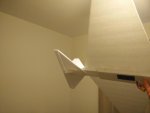Centus
Member
Hi all,
Newbie to R/C flying and Flitetest here! I'd like to show y'all my FT Flyer build that I just finished last night which includes a simple but hopefully worthy modification.
Quick backstory, last week I built my first foamie (a FT Mustang) from the speed-build kit. It went really well and was alot of fun! I took it out for her maiden flight and crashed her twice before I realized that my aileron channel was reversed! DOH! I have the HK T6a v2 radio, so I had to order the connector cable in order to reverse that channel. I'm grounded for a week.
In the meanwhile, I decided I would scratch build an FT Flyer from the plans. This plane has no ailerons, so my controller would not be a problem! Also since the FT Flyer is a beginner plane I can use it to get better at flying before I ruin my nifty Mustang. My only power pod is the "C" pack from Flitetest, and I read on the forums that the Flyer isn't big enough to carry the BEEF. I figured a modification to the wing size had to be made to improve the flight characteristics with the additional weight and power.
I did some weight calcs and figured out that the FT flyer with the BEEF is ~60% heavier than the Flyer with the recommended electronics. To generate the additional lift (at the same speed and AoA) I had to increase the area of the wings. I did this by increasing the wingspan, which I figured was the simplest way to increase the lift without changing the longitudinal center of lift of the wings (much, anyway). The span of one wing of the FT flyer is 13.0 inches, and I increased this dimension to the full width of a DTFB (20"). I kept the same tip chord as the original plan, therefore increasing the wing area by 54%. The increase in my lift-curve slope due to the increased aspect ratio will hopefully take me up over the 60% increase in required lift. The only other modification was moving the tail aft slightly, about 1", which should improve the control authority a little.
The result came out pretty good and I'm proud of my first scratch build from plans! I do realize that I've increased the stress in the wing-fuselage joint significantly with this mod, so no high G maneuvers! Anyway, if I fold the wings I'll just figure out a way to reinforce this area!
Enjoy the pics!



Newbie to R/C flying and Flitetest here! I'd like to show y'all my FT Flyer build that I just finished last night which includes a simple but hopefully worthy modification.
Quick backstory, last week I built my first foamie (a FT Mustang) from the speed-build kit. It went really well and was alot of fun! I took it out for her maiden flight and crashed her twice before I realized that my aileron channel was reversed! DOH! I have the HK T6a v2 radio, so I had to order the connector cable in order to reverse that channel. I'm grounded for a week.
In the meanwhile, I decided I would scratch build an FT Flyer from the plans. This plane has no ailerons, so my controller would not be a problem! Also since the FT Flyer is a beginner plane I can use it to get better at flying before I ruin my nifty Mustang. My only power pod is the "C" pack from Flitetest, and I read on the forums that the Flyer isn't big enough to carry the BEEF. I figured a modification to the wing size had to be made to improve the flight characteristics with the additional weight and power.
I did some weight calcs and figured out that the FT flyer with the BEEF is ~60% heavier than the Flyer with the recommended electronics. To generate the additional lift (at the same speed and AoA) I had to increase the area of the wings. I did this by increasing the wingspan, which I figured was the simplest way to increase the lift without changing the longitudinal center of lift of the wings (much, anyway). The span of one wing of the FT flyer is 13.0 inches, and I increased this dimension to the full width of a DTFB (20"). I kept the same tip chord as the original plan, therefore increasing the wing area by 54%. The increase in my lift-curve slope due to the increased aspect ratio will hopefully take me up over the 60% increase in required lift. The only other modification was moving the tail aft slightly, about 1", which should improve the control authority a little.
The result came out pretty good and I'm proud of my first scratch build from plans! I do realize that I've increased the stress in the wing-fuselage joint significantly with this mod, so no high G maneuvers! Anyway, if I fold the wings I'll just figure out a way to reinforce this area!
Enjoy the pics!






